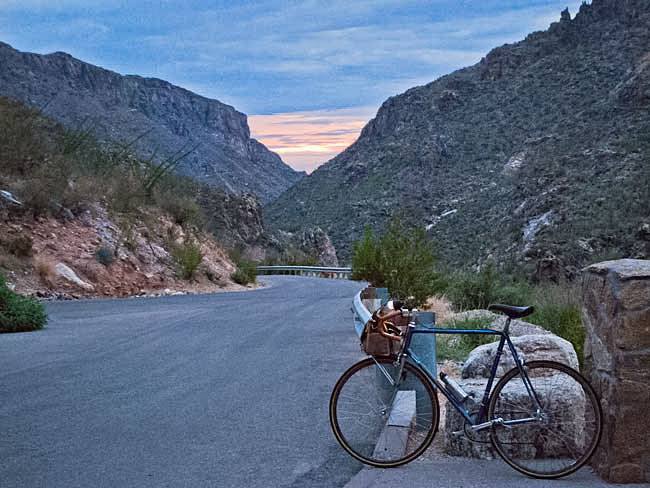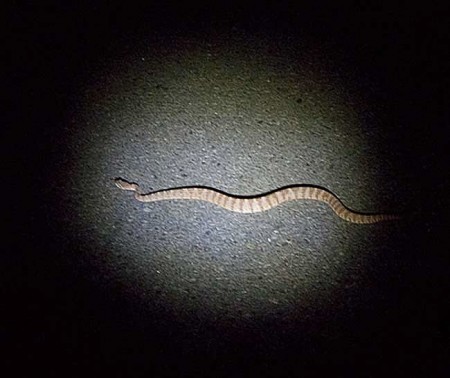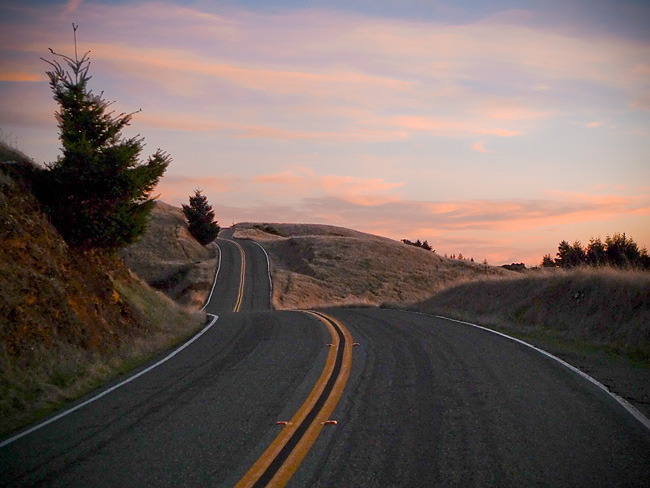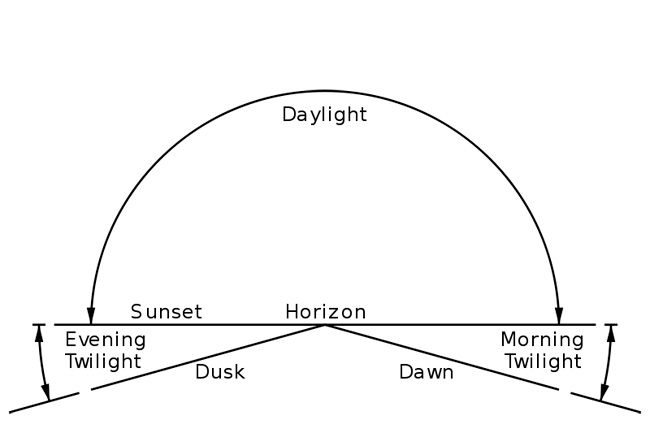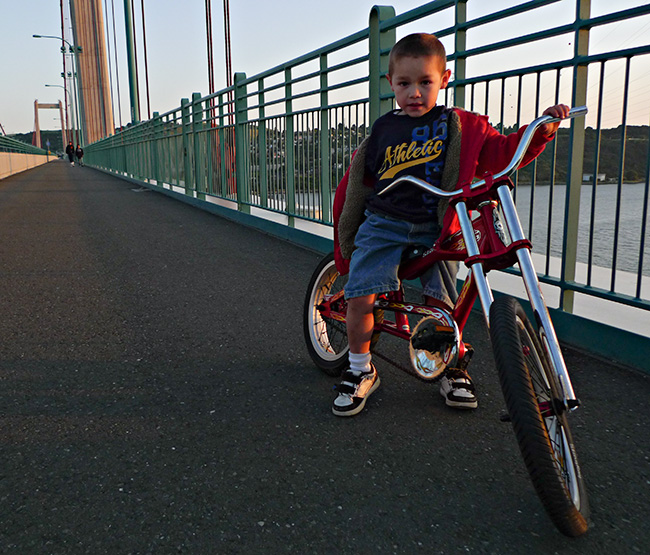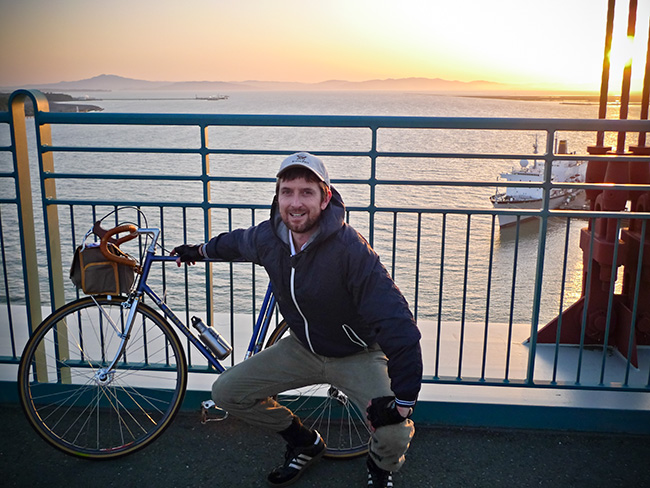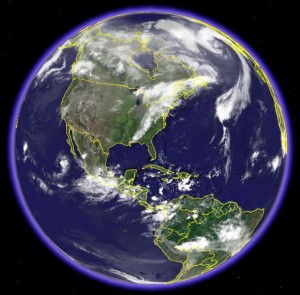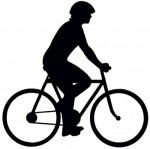Archive for the ‘twilight’ tag
On the Road……Saguaro National Park at dusk
The warm glow of the desert at dusk.
I passed one car and one rattlesnake during the ride. Plus, I got to see the sunset.
On the Road……A rattlesnake encounter in Sabino Canyon
This is the end of Sabino Canyon’s paved road. Mosquito’s are biting my forearms and shoulders. Twilight is descending (note: for a twilight ride overlooking the Pacific Ocean see this post).
As I’m heading home, about halfway down the mountain, the light is 85 percent gone. Coasting slightly downhill at about 10-15 mph, I suddenly notice a shape in front of my wheel. Without thinking, I swerve. Actually, there wasn’t enough time to swerve; rather it was just a quick flick of the wrist and handlebars — first right, then left.
I immediately look back over my left shoulder and see a snake falling to the ground, as if recoiling from a near vertical strike.
The part of my brain that processes information informs me that the sensation I felt against my leg a fraction of a second ago was the rattlesnake defending itself against what it perceived as a large, warm-blooded creature (that is, me) bearing down on it.
I stopped my bicycle; went back up the road 20 feet; directed my headlight to illuminate the scene; and snapped this picture!
The encounter reminded me of one of my favorite pieces of writing — Snaketime — an essay originally published in the WildEarth Journal by Charles Bowden (re-printed in this book, which as of August 2011 had copies available for $.01).
Here’s an excerpt where Bowden suggests how a snake perceives the world:
For the snake a few things are obvious: I am large, and this is certain because of my footfall. She can hear the footfall of a mouse. I am rich in odor. She can pick up the faintest scents, identify them, and follow a single strand as clearly as if it were signage on an interstate highway system…And I am irrelevant unless I get too close. She will ignore me if I stay six feet away. She will ignore me if I become motionless for 180 seconds.
If I violate the rules of her culture, she will work through a sequence of four tactics. First, she will pretend to be invisible and hope I do not see her. If that fails, she will try to flee. If that fails, she will rattle in hope of frightening me away. And finally, if I am completely ignorant of simple courtesy and get within a foot or so of her, she will attack me…
She herself is cultured. In her lifetime, she will attack maybe twenty or thirty or forty times. She will never attack any member of her own species. She will never be cruel. She is incapable of evil.
–Charles Bowden, from the essay Snaketime
Nathan
On the Road……Atop the Bolinas Ridge at Civil Twilight
This image from my recent ride along the Bolinas Ridge captures the specific time of the evening — civil twilight — when ambient light takes on a lovely bluish hue prized by painters and photographers.
Twilight, broadly speaking, refers to the time between sunset and dusk AND the time between sunrise and dawn (the chart below is a helpful tool for visualizing this).
But twilight (both morning and evening) is divided, more scientifically, into civil, nautical, and astronomical segments based upon the number of degrees the center of the sun is below the horizon (6, 6-to-12, and 12-to-18 degrees respectively).
Evening nautical twilight (nautical dusk) is said to end once sea navigation via the horizon line is no longer possible. Evening astronomical twilight (astronomical dusk) ends once the dimmest celestial objects (e.g. galaxies and nebulae) become properly visible to astronomical observation.
Commentary: in the context of the virtual world of Texting, Tweeting, and Tagging (from which I claim no exception) it feels palpably iconoclastic (if not downright subversive) to patiently witness our solar system’s sun disappearing ever so gently beyond the planet’s watery horizon.
Featured Comment by Shoeless Joe: “There is a biological connection, too, as the rods and cones in our eyes perceive light differently at twilight. It is called the Purkinje Shift (or Purkinje Effect). Wikipedia has a good article on it. One of the beauties of cycling is that it affords many opportunities to “patiently witness” the world around us in a way that is unique to the sport.”
Ride Report……Port Costa Loop, Part II
Long overdue, this is Part II of my ride report.
(Here is Part I and here again is the map of the route).
The broad outlines of this ride came to me as I looked at the location of my friends’ house on a map. This would be a circumnavigation, via two major urban bridges, of the Carquinez strait — a watery narrows that California’s two mighty rivers, the Sacramento and San Joaquin, must pass through before emptying into the San Pablo and San Francisco Bays.
Port Costa — surrounded by rolling green hills — was the perfect launching point for such a ride.
Miles 0-10: From Port Costa to Martinez bicyclists can use the old highway, which is closed to car traffic. I passed the occasional hiker and was treated to rolling hills, scenic views of the water and the old rail road tracks, and a final, satisfying descent into the town of Martinez. I breezed in feeling energized and thus decided to go looking for the John Muir historic monument rather than sticking to the course I had initially set. (Read about that side trip here).
Miles 11-20: The second third of the trip took me from downtown Martinez across the Benicia Bridge to Southampton Bay and the Benicia state recreation area. This was easy, pleasant riding never too far from the shoreline. I rode past past marinas filled with expensive yachts and late Sunday afternoon picnic goers. I stopped frequently to make photographs and found my way using a variety of bike paths and shared roads. I was never entirely sure if I was on my planned route, but I wasn’t too concerned as “Bike Route” signs were plentiful and all roads seemed to propel me toward the state park.
Miles 21-30: During the last third of the trip, after leaving Benicia state park, the route finding and bicycle riding became more difficult. The bike lane ended and I had to navigate a number of challenges:
- first was a curving, shoulder-less off-ramp leading up to Columbus Parkway and a narrow two-way bridge near the intersection with I-780.
- route finding became more difficult since I screwed up my Google bicycling directions by accidentally printing a mirror image of the route (starting at point B going to A, rather than A to B). As a result, I had to read the directions backwards (from the bottom of the page up) and calculate whether left and right turns were also reversed. It was a mess.
- a critical street sign was missing and as I pedaled up what seemed the biggest incline of the trip I was unsure if was even on the correct road (later I confirmed I was on Benicia Rd.).
- in order to find the approach to the bike/ped path of the Carquinez Bridge I had to cross three major interstates (I-780 2 times and I-80 once) and pedal through a few gritty urban neighborhoods (riding in normal street clothes, rather then a skintight lycra outfit, never felt more right).
- since I began my journey after 4:30pm the onset of darkness was a real issue (I don’t have a lighting system on this bike).
So, I pedaled hard the last 6-7 miles, crossed the Carquinez Bridge as the sun dropped below the horizon, and managed to arrive back in Port Costa just after 8pm.
My friends had taken a twilight stroll and were not yet home. I was a little tired and rather hungry (since I didn’t eat anything on route), but took solace in the satisfaction of having just circumnavigated the Carquinez Strait.

 Show on map
Show on map